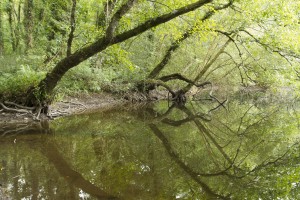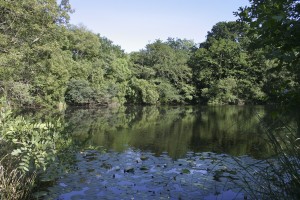Enclave Name: Ollos de Begonte
Protection Category: Included LIC ES1120003 Parga-Ladra-Támoga.
Location: Pertaining to the municipality of Outeiro de Rei, Lugo.
Region: Galicia
Reference Coordinate: 1Km E2891N2398
Wetland Surface: 1 ha
Altitude: 395 m
Within the upper basin of the Miño River it is possible to visit wetlands in which the underground water flow has an equal or higher importance to the overland flow. This is the case of deep lagoons of underground water flow known locally as “Ollos”.
The enclave known as Ollos de Begonte includes two circular ponds, 150m apart, originated from a karst gulf, which upon increase in size was eroding cenozoic sedimentary materials in the surface layers. From the complex geological and geomorphological evolution two lagoons emerged, the largest of which is 45 meters in diameter and a maximum depth of 18 meters.
Another important aspect is that the wetland is located near the confluence of two great rivers (the Parga and Ladra) whose flood regimen affects the hydrology of the wetland. During the winter period the adjoining forest remains flooded on both channels, making fa ree sheet of water observable from the river channel to the basin of the Ollos de Begonte.
The ownership of the wetland corresponds to the County Council of Lugo, who acquired the land for the development of a LIFE project (LIFE 00 NAT_E_007311), establishing the main uses the conservation of environmental assets and the use of public space. All the wetland is within the Site of Community Importance and Natural Assets Special Protection Area, Parga – Ladra – Támoga. Given its conservation interest, this enclave is included within the Area “Protection Area” as reflected in the Master Plan for the Natura 2000 network of Galicia.
The whole complex in which the enclave Ollos de Begonte is integrated is located within the core zone of the Biosphere Reserve Terras do Miño.
- MORE RELEVANT FEATURES
For its origin and location the Ollos de Begonte contain a significant representation habitats types linked to wet environments, both strictly aquatic character, as hygrophilous or peatland.
Among the habitats that have been inventoried the calcareous fens of Cladium species mariscus and Caricion davallianae ( 7210 *) and oligo-mesotrophic waters with calcareous benthic vegetation of Chara spp. ( 3140 ) stand out. Both habitat types are rare in the network of protected areas in Galicia , with the SCI Parga – Ladra Támoga the only non – coastal Galicia having a representation of priority habitat 7210 * .
The two lagoons in the Ollos de Begonte have been surrounded by different kinds of climatic forests : forests of flood ( 91F0 and 91E0 *) and Galician- Portuguese forests of Quercus robur and Q. pyrenaica ( 9230 ) with fallen leaf inputs determine the dystrophic character the smaller part. In the winter period the large amount of flood water that collects in the area provides a direct connection between the lake and the main river channel area , while in the summer and autumn period the water is reduced, remaining in a complex system of meandering channels and small ponds included within the swamp forest, hosting a diverse aquatic flora and fauna.
Habitats of Community Interest
Código Denominación 3140 Aguas oligomesotróficas calcáreas con vegetación béntica de Chara spp. 3160 Lagos y estanques distróficos naturales 3270 Ríos de orillas fangosas con vegetación de Chenopodion rubri p.p. y de Bidention p.p. 6410 Prados con molinias sobre sustratos calcáreos, turbosos o arcillo-limónicos (Molinion caeruleae) 6430 Megaforbios eutrofos hidrófilos de las orlas de llanura y de los pisos montano a alpino 6510 Prados pobres de siega de baja altitud (Alopecurus pratensis, Sanguisorba officinalis) 7210* Turberas calcáreas del Cladium mariscus y con especies del Caricion davallianae 91E0* Bosques aluviales de Alnus glutinosa y Fraxinus excelsior (Alno- Padion, Alnion incanae, Salicion albae) 91F0 Bosques mixtos de Quercus robur, Ulmus laevis, Ulmus minor, Fraxinus excelsior o Fraxinus angustifolia, en las riberas de los grandes ríos (Ulmenion minoris) Fauna
In this enclave are invertebrate populations of conservation concern for their degree of threat, such as the pearl mussel (Margaritifera margaritifera) species of community interest shown in Annex II and IV of the Habitats Directive, or Naiad pictorum Unio, species classified as Vulnerable in the Galician Endangered Species List.- PHOTOS



